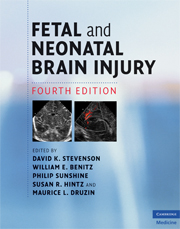Book contents
- Frontmatter
- Contents
- List of contributors
- Foreword
- Preface
- Section 1 Epidemiology, pathophysiology, and pathogenesis of fetal and neonatal brain injury
- Section 2 Pregnancy, labor, and delivery complications causing brain injury
- Section 3 Diagnosis of the infant with brain injury
- 16 Clinical manifestations of hypoxic–ischemic encephalopathy
- 17 The use of EEG in assessing acute and chronic brain damage in the newborn
- 18 Neuroimaging in the evaluation of pattern and timing of fetal and neonatal brain abnormalities
- 19 Light-based functional assessment of the brain
- 20 Placental pathology and the etiology of fetal and neonatal brain injury
- 21 Correlations of clinical, laboratory, imaging, and placental findings as to the timing of asphyxial events
- Section 4 Specific conditions associated with fetal and neonatal brain injury
- Section 5 Management of the depressed or neurologically dysfunctional neonate
- Section 6 Assessing outcome of the brain-injured infant
- Index
- Plate section
- References
21 - Correlations of clinical, laboratory, imaging, and placental findings as to the timing of asphyxial events
from Section 3 - Diagnosis of the infant with brain injury
Published online by Cambridge University Press: 12 January 2010
- Frontmatter
- Contents
- List of contributors
- Foreword
- Preface
- Section 1 Epidemiology, pathophysiology, and pathogenesis of fetal and neonatal brain injury
- Section 2 Pregnancy, labor, and delivery complications causing brain injury
- Section 3 Diagnosis of the infant with brain injury
- 16 Clinical manifestations of hypoxic–ischemic encephalopathy
- 17 The use of EEG in assessing acute and chronic brain damage in the newborn
- 18 Neuroimaging in the evaluation of pattern and timing of fetal and neonatal brain abnormalities
- 19 Light-based functional assessment of the brain
- 20 Placental pathology and the etiology of fetal and neonatal brain injury
- 21 Correlations of clinical, laboratory, imaging, and placental findings as to the timing of asphyxial events
- Section 4 Specific conditions associated with fetal and neonatal brain injury
- Section 5 Management of the depressed or neurologically dysfunctional neonate
- Section 6 Assessing outcome of the brain-injured infant
- Index
- Plate section
- References
Summary
Introduction
Following the birth of a depressed newborn, the infant's caretakers are involved in providing appropriate resuscitative techniques, stabilizing the infant's biochemical and physiological abnormalities, and evaluating the infant's response to these measures. The caretakers must also ascertain the cause of the infant's depression, attempt to determine when the event or events leading to the depression occurred, and develop a plan for follow-up evaluation and treatment that will be required. The determination of causation and timing not only has medical–legal implications, but also is becoming extremely important in order to evaluate the types of therapy that may be utilized to mitigate the effects of an asphyxial event. If the infant had suffered significant damage days or weeks prior to birth, then these rescue forms of therapy will have little, if any, beneficial effect on the infant's eventual outcome. In many situations, this determination is very difficult to make, as there may be a myriad of events that could have occurred prior to the time of birth, and overlapping of significant problems makes this exercise an almost impossible task at times.
Identification of the etiology of a cerebral injury is a critical prerequisite to the determination of its timing. For example, lactic acidemia immediately after birth and an elevated serum creatine kinase (CK) level at 24 hours of age in an infant with abnormal intensities of T1- and T2-weighted signals in the basal ganglia on MRI obtained at 2 weeks of age might point to intrapartum timing of an acute hypoxic–ischemic insult.
- Type
- Chapter
- Information
- Fetal and Neonatal Brain Injury , pp. 255 - 264Publisher: Cambridge University PressPrint publication year: 2009



